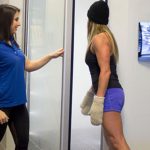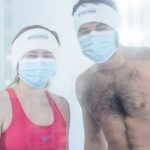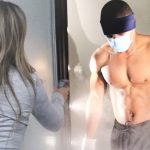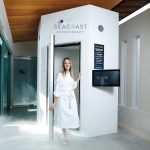EVERYTHING TO KNOW BEFORE RECEIVING TREATMENT
What happens during a whole-body cryotherapy session?
THE REACTIVITY IN THE BRAIN IS TWO-FOLD
Whole-body cryotherapy, from a review of various studies and sources, shows two very prominent systemic responses. The “cold-shock” reaction happens when you enter the chamber and skin temperature all over the body drops rapidly. The thermoreceptors (nerve ending neurons) send distress signals to the brain.
First, there is a Central Nervous System (CNS) reaction where endorphins are quickly released in vast amounts. Endorphins generally elevate mood and block pain reception signals. Additionally, norepinephrine is released (said to be twice the average producing levels) triggering vasoconstriction. Clients experience improved range of motion with pain reduction almost immediately as restrictive connective tissue relaxes without pain reception.
Additionally, the brain initiates a parasympathetic (Autonomic Nervous System) reaction. Blood draws from the extremities to the core to protect vital organs. This occurs within 30 seconds to one minute of exposure. Blood in the core oxygenates and is enriched with nutrients. When you exit the chamber, as the skin temperature rapidly rewarms, the brain releases the blood supply back to the extremities. This process flushes areas of injury of toxic waste and bad cells, replenishing with fresh blood to stimulate cellular regeneration.
WHOLE-BODY CRYOTHERAPY TREATMENT PROCESS:
GETTING READY

What to wear and how to prepare before entering the chamber.
Prior to chamber entry, we will give you necessary protective wear. We recommend minimal clothing, and you can wear whatever you’re comfortable in, as long as there’s no metal. You must be completely dry to prevent frostbite. We measure and record every treatment session with start and exit temperatures. A certified staff member will give you a full explanation of the process, and safety instructions to ensure an optimal experience.
INSIDE THE CHAMBER
 What to do and what’s happening during treatment in the chamber.
What to do and what’s happening during treatment in the chamber.
The air in the chamber is dry, breathable oxygen-rich air. Due to the lack of moisture (humidity), it is not painful like an ice bath. You can breathe and move normally in the chamber. During the treatment, your skin temperature will decrease between 30-45 degrees over the +/-3 minutes inside the chamber. The chamber doors can’t lock, so if you feel uncomfortable, you can easily exit at any time.
EXITING THE CHAMBER
 How you’ll feel and what to do after you leave the chamber.
How you’ll feel and what to do after you leave the chamber.
When you step out of the chamber, you may feel exhilarated or energized. Our staff will record your skin temperature and discuss results. You will immediately start to warm after exiting the chamber, with full range of motion in your muscles and joints, unlike water or ice treatments, where the joints remain stiff. We recommend you drink more water than usual for the next 24-48 hours.
What are the benefits of whole-body cryotherapy?
 There are numerous benefits from cryotherapy treatments. Cryotherapy supports overall wellness and health by helping your body’s natural healing processes. Whole-body and localized cryotherapy are used to relieve pain, decrease inflammation, speed recovery time, increase athletic performance, and reduce muscle soreness. Some additional benefits include: pain relief from chronic medical conditions, boosted metabolism, increased circulation throughout your body, and improvement of mood disorders such as anxiety and depression. This cutting-edge treatment assists with clearing of skin conditions such as eczema and acne, it can reduce the appearance of cellulite, and give you tighter, more youthful looking skin.
There are numerous benefits from cryotherapy treatments. Cryotherapy supports overall wellness and health by helping your body’s natural healing processes. Whole-body and localized cryotherapy are used to relieve pain, decrease inflammation, speed recovery time, increase athletic performance, and reduce muscle soreness. Some additional benefits include: pain relief from chronic medical conditions, boosted metabolism, increased circulation throughout your body, and improvement of mood disorders such as anxiety and depression. This cutting-edge treatment assists with clearing of skin conditions such as eczema and acne, it can reduce the appearance of cellulite, and give you tighter, more youthful looking skin.
Athletic Performance and FitnessTriggers anti-inflammatory response Accelerates healing Increases range-of-motion Reduces muscle soreness and duration Speeds injury recovery Reduces pain and inflammation Replaces ice baths and ice packs Maximizes benefits of other physical therapy |
Overall Health and WellnessBoosts metabolism Promotes better sleep Decreases pain and inflammation Increases mobility and range-of-motion Increases endorphin and norepinephrine production and release Stimulates cellular regeneration Increases blood and lymphatic flow Accelerates healing |
Appearance and ComplexionStimulates collagen production–increasing elasticity and reducing wrinkles Tightens skin Enhances micro-circulation Reduces puffiness Clears blemishes Calms irritations Brightens skin Stimulates hair follicles |
What happens during local cryotherapy treatments?
Local cryotherapy is delivered with a hand-held device that targets cold air treatments to a specific injured area. Here we flush that area as our devices cool the skin (locally) causing a “run” from the temperature. This signals the body to hold the blood supply back, adding to the anti-inflammatory result in an area, followed by targeted delivery of enriched blood supply back into the area upon rewarming. We can complement the systemic whole-body cryotherapy (followed by a brief period of re-warming for rapid revascularization), or perform the local treatment as a stand-alone therapy.
What happens during a cryofacial?
The clinician will use a hand-held device to direct the sub-zero air stream on your neck, face and scalp. Here we flush each area, from the top of the head down to the chest and shoulder area. This cools the skin causing a “run” from the temperature. This signals the body to hold the blood supply back, followed by targeted delivery of that enriched blood supply back into the area upon rewarming. The increased blood flow also reduces inflammation and puffiness in the face and eyes. Repeated facial sessions will increase the natural production of collagen, a protein which allows the skin to be more elastic overtime, reducing and even eliminating wrinkles and other blemishes. Treatment on the scalp stimulates hair follicle growth for a thicker and healthier head of hair.
The cryofacial has also proven to be effective on clients with eczema, psoriasis, rosacea, scarring, and other inflammatory skin issues.
What should I wear in the cryotherapy chamber?
The treatment is most effective when as much skin as possible is exposed. We provide a changing area and a robe. Our gloves, socks, headwear and footwear are worn in the chamber to protect your extremities. Men are required to wear boxers, underwear, swimwear, or sports shorts. Women can wear swimwear or sports shorts/sports bra or top. No metal underwire. All clients must remove all jewelry and exterior metal/body piercings. It is important that skin, hair, and all clothes worn in the chamber are dry to prevent frostbite.
What should I wear for my local cryotherapy treatment?
For your local treatment, the area of your body being treated will need be dry and exposed. Wear loose clothes to your appointment, or bring shorts, tank top, or t-shirt to change into for treatment.
What should I wear to my cryofacial?
You can wear any clothing to your cryofacial appointment. You’ll change into a spa towel top for treatment, but can leave all lower clothing on. Makeup does not need to be removed, but skin and hair need to be dry.
What are the risks of cryotherapy?
Cryotherapy is a relatively risk-free treatment, but there are contradictors. No nitrogen or hazardous gasses are used. Our state-of-the-art electric chamber cools regular, breathable air. Protective clothing, such as socks, gloves, headband, earmuffs, underwear, swimwear, and sportswear, skin and hair must be dry to prevents frostbite. For a full list of contraindicators and precautions, please see our consent form.
How cold does it get?
In the whole-body cryotherapy chamber, the temperature of the air in the chamber is cooled to -110ºC (-230ºF). The air in the chamber is extremely dry, and generally the cold is not unpleasant. Because the process is short, about 3 minutes, it is bearable for the duration. You immediately start to warm up upon exiting the chamber.
What is the difference between a whole-body cryotherapy chamber and and a cryosauna, where the head is exposed?
A cryosauna works with nitrogen in order to reach a temperature of -180°C. When using nitrogen, you cannot expose your head to the cold, even though this is where 30% of all your cold receptors are located. Also, the temperature distribution in this type of chamber is not uniform: the nitrogen quickly sinks downward. In our cryochamber, electrical equipment ensures the temperature is maintained at -110°C. The whole chamber is subject to a stable, uniform temperature, which increases the effect of the treatment. No nitrogen or hazardous gasses are used st Seacoast Cryotherapy. Our state-of-the-art electric chamber cools regular breathable air.
Who is cryotherapy for?
Whole-body cryotherapy makes sense to a lot of people, but is it right for you? If you have any of the following, you may want to try whole-body cryotherapy and/or local cryotherapy as part of your treatment:
| Rheumatoid arthritis Osteoarthritis, osteoporosis Recent or old soft-tissue injuries Joint pain Shin splints Frozen shoulder Muscle sprains or tears Inflammation of tendons Inflammation of bursa (bursitis) Epicondylitis (tennis elbow) Back pain |
Carpal tunnel syndrome Tarsal tunnel syndrome Plantar fasciitis Fibromyalgia Chronic pain syndromes Headaches and some migraines Anxiety Depression Ankylosing Spondylitis Multiple sclerosis |
Post-surgery inflammation Muscle soreness, pain Exercise induced muscle fatigue Sports injuries Jet lag Hangover Fatigue Sleeplessness or sleep disorders Psoriasis Eczema |
Who shouldn't use cryotherapy?
If you have any of the following, WBC is not for you:
| Pregnancy Frostbite Hypertension Low blood pressure High blood pressure Acute or recent myocardial infarction Unstable angina pectoris Arrhythmia Symptomatic cardiovascular disease Cardiac pacemaker Peripheral arterial occlusive disease Venous thrombosis Cold-induced Asthma |
Acute or recent cerebrovascular accident Uncontrolled seizures Severe Raynaud’s Syndrome Fever Tumor disease Symptomatic lung disorders Bleeding disorders Severe anemia Infection Cold-allergy Acute kidney and urinary tract diseases Active cancer |
For a full list of contraindicators and precautions, please see our consent form.
When was cryotherapy invented?
There is evidence from as early as 2500 B.C. that ancient Egyptians used cold to treat diseases and other ailments. The modern-day cryotherapy chamber was first conceived in Japan in 1978 by Dr. Toshima Yamaguchi, as a treatment for his patients suffering from rheumatoid arthritis. Since that time, the chamber has been further developed and refined in Europe, and now wide-spread whole-body cryotherapy is popular all over the world.
Multiple research studies have been published in medical journals about the effects of whole-body cryotherapy, and in many European countries the treatments are covered by medical insurance policies.
Researchers are continuing to actively study the impact of cryotherapy in many areas.

Where can I find research on cryotherapy?
META-STUDY ON WHOLE-BODY CRYOTHERAPY
Whole-Body Cryotherapy in Athletes: From Therapy to Stimulation. An Updated Review of the Literature. Read the research >
ADDITIONAL PUBLISHED RESEARCH STUDIES
National Center for Biotechnology Information site, a division of the U.S. National Library of Medicine as part of the National Institutes of Health. Read the studies >



